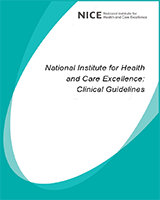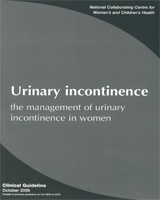Most women can be treated successfully for OAB with conservative measures but a small proportion with more severe symptoms may require surgery. Sacral nerve stimulation (SNS) is a relatively new but effective treatment option for patients in this category but is expensive and currently only available in a limited number of centres in the UK. However, alternatives to SNS often involve major surgery, such as augmentation cystoplasty or urinary diversion, and are also expensive. The associated long-term morbidity, and risk of further surgical intervention, appears to be higher for cystoplasty and urinary diversion than it is for SNS, therefore a cost–consequence analysis was undertaken.*
Literature review
A literature review did not identify any studies that carried out a full economic evaluation of SNS for patients with UI, although, a cost analysis was undertaken for a report by the Australian Medicare Services Advisory Committee (MSAC).934 A full economic analysis was not considered by MSAC because of uncertainty about treatment costs, particularly in relation to patients for whom the implant is unsuitable or fails. The authors also justified their costing approach because of uncertainty surrounding treatment on health outcomes.
The MSAC report estimated that the 6 month treatment costs of SNS for patients with urge incontinence or urinary retention were AUD11,000 per patient initiated to treatment with percutaneous sacral nerve evaluation (PNE). PNE equipment and implant cost accounted for AUD6,567 and surgery and re-surgery costs for AUD4,464. It was further estimated that SNS could produce savings of between AUD245 and AUD574 per patient in laundry costs and incontinence products over the 6 month period. The report noted that such savings would increase if the device continued to be effective but they also noted that not all revision surgery may be captured in the first 6 months. Using data from the literature,515 they estimated that approximately 30% of urge incontinence patients tested with PNE would be dry at 6 months with a cost effectiveness ratio of AUD35,000 (95% CI AUD28,000 to AUD 46,000) per additional person free of incontinence when compared with no treatment.
Cost analysis
The costings are based on a successfully treated patient over 10 years. However, there are clearly patients with all treatments who do not have successful outcomes. Such patients will then go down a different treatment pathway that also has resource implications, which could be considerable. A full costing analysis would account for this but it was not possible to do this fully within the constraints of the guideline. However, where data are available, some indication of alternative pathways will be given in the event of treatment failure. Costs that are known to occur in the future are discounted at a rate of 3.5% per annum:
Sacral nerve stimulation
View in own window
| Item | Unit cost | Source of cost data |
|---|
| Percutaneous nerve evaluation | £687 | Procedure – 2004 NHS Reference Costs (HRG code R19, day case) |
| £1,200 | Tined lead |
| Permanent implant | £687 | Procedure – 2004 NHS Reference Costs (HRG code R19, day case) |
| £6,870 | Implant device |
Total initial treatment cost = £9,444
Approximately 50% of patients get sufficient improvement in symptoms from PNE to proceed to the permanent implant. Other treatment options would have to be considered for the patients who are deemed not suitable for SNS after PNE.
Of those who have the permanent implant, approximately 65–70% have a satisfactory outcome. In those where the outcome is unsatisfactory, augmentation cystoplasty or urinary diversion may be considered.
A battery change is required after 7 years and costs £4,400. This would again require a day case procedure (HRG code R19). A proportion of patients with satisfactory SNS outcomes will also require revision surgery, which is usually undertaken as a day case procedure. Estimates of the requirement for further surgery are indicated below.512
surgical revision rate: 33%
replacement or relocation of implanted pulse generator: 15%
permanent device removal: 9%
Augmentation cystoplasty
View in own window
| Item | Unit cost | Source of cost data |
|---|
| Procedure | £3,440 | 2004 NHS Reference Costs (HRG code L14) |
Total initial treatment cost = £3,440
It has been estimated that:536
80% of patients treated would need to self-catheterise.
6% will need a re-operation for bleeding or for bowel obstruction. This would be a major abdominal procedure with a 2004 NHS Reference Cost of between £1,600 and £3,000 depending on age (HRG code F41/F42).
25% of patients will have symptomatic infections and need long-term antibiotics (low-dose trimethoprim or cefalexin and receive six full-week courses of oral ciprofloxacin per annum).
There is a 60% cumulative risk of stones over 10 years, and this will usually require intermediate bladder endoscopy to resolve (code L18), which has a NHS 2004 Reference Cost of between £500 and £1,000 depending on whether it is done as a day case or elective inpatient procedure.
Long-term complications mean that about 6% of patients need repeat abdominal surgery within 10 years. This repeat surgery would cost £3,440 or more if a conversion to urinary diversion was considered.
Urinary diversion
View in own window
| Item | Unit cost | Source of cost data |
|---|
| Procedure | £5,536 | 2004 NHS Reference Costs (HRG code L14) |
Total initial treatment cost = £5,536
Furthermore, it has been estimated that:935
All patients would need to use stoma products for the rest of their lives.
There is a 60% cumulative risk of stones over 10 years which usually require intermediate bladder endoscopy to resolve (HRG code L18).
25% of patients will have symptomatic infections and need long-term antibiotics (low-dose trimethoprim or cefalexin and receive six full-week courses of oral ciprofloxacin per annum).
The risk of stoma complications is approximately 80% over 10 years and, of these, approximately 50% would require revision surgery, which would cost between £1,600 and £3,000 depending on age
Botulinum toxin A
View in own window
| Item | Unit cost | Source of cost data |
|---|
| Botulinum A (200 units) | £258 | BNF 51 |
| Procedure | £458 | 2004 NHS Reference Costs (HRG code L19, day case) |
A patient successfully treated would require repeat injections every 8 months. Future treatment costs were discounted using a 3.5% annual discount rate to give the 10 year cost of treatment.
10 year treatment cost = £9,296
Additionally, it has been estimated that 20% of patients would fail to respond with botulinum toxin A and these patients would be considered for alternative treatment after their initial injections. Of the patients who continue, 20% would need to self-catheterise half the time.
Cost–consequence comparison
View in own window
| Treatment | Cost (10 year) | Consequences |
|---|
| Sacral nerve stimulation | £8,437 + replacement battery + surgical revisions | Up to two-thirds of patients achieve continence or substantial improvement in symptoms after SNS; the available data show that beneficial effects appear to persist for up to 3–5 years after implantation. Around one-third of patients may require re-operation, most often owing to pain at the implant site, infection, or the need for adjustment and modification of the lead system. Permanent removal of the electrodes may be required in one in ten patients. Developments in the devices and leads have resulted in reduced rates of complications since introduction of the technique. |
| Augmentation cystoplasty | £3,440 + complication costs + self-catheterisation costs | Data on augmentation cystoplasty in women with UI or OAB are limited to case series. Cure or improvement has been reported in at least half of patients with idiopathic DO. Postoperative complications such as bowel disturbance, metabolic acidosis, mucus production and/or retention in the bladder, UTI and urinary retention are common or very common. There is a high incidence of recurrent UTI postoperatively, and many patients will need to self-catheterise. Malignant transformation in the bowel segment or urothelium has been reported in a small number of cases. |
| Urinary diversion | £5,536 + complication costs | There are limited data on the outcomes of urinary diversion in women with UI or OAB. Where the procedure has been used in men and women with benign conditions, vesical infection, stoma-related problems and the need for surgical revisions occur very commonly. |
| Botulinum toxin A | £9,296 + self-catheterisation costs | Data on the use of botulinum toxin A in the management of idiopathic detrusor overactivity are limited. The available data show cure or improvement in about half of patients, with duration of benefit between 3 and 12 months. |
Discussion
This guideline has made a recommendation that SNS be used in the treatment of UI due to DO in women who have not responded to conservative treatments and we expect it to be a low-volume intervention. SNS has high initial treatment costs and requires a battery replacement after approximately 7 years. However, as this cost–consequence analysis shows, the alternative treatment options for this group of women with refractory incontinence are all expensive, and the incremental costs of SNS when compared with the alternatives are much less (and possibly even negative) than when looking at the costs of SNS in isolation.
A cost–consequence analysis does not demonstrate cost effectiveness and it is difficult to compare effectiveness in a quantitative way. However not only does major surgery such as augmentation cystoplasty or urinary diversion carry a high cost over time but the morbidity is also high and only around 50% of patients are satisfied with the outcome. Although botulinum toxin A injection appears to offer promising results the current evidence is limited; it is assumed that repeated injections will be required. The incremental costs over time are therefore likely to be very high. We believe that this cost–consequence analysis provides an economic justification for the recommendation made.
- *
Cost–consequence analysis is a limited form of economic evaluation that considers costs alongside consequences (or outcomes) without calculating an ICER. It was not possible within the constraints of this guideline to undertake a more sophisticated economic evaluation, especially as these treatment options are likely to be low volume.


